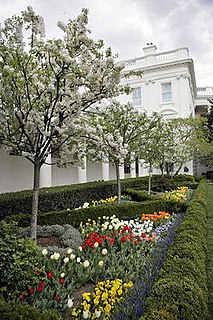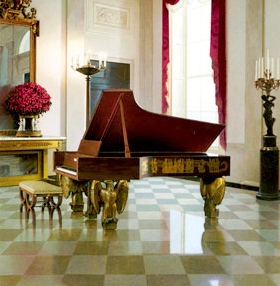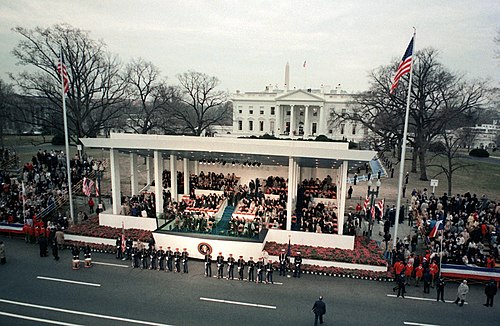
The White House is the official residence and workplace of the president of the United States. It is located at 1600 Pennsylvania Avenue NW in Washington, D.C. and has been the residence of every U.S. president since John Adams in 1800. The term "White House" is often used as a metonym for the president and his advisers.

The Oval Office is, since 1909, the working office space of the president of the United States, located in the West Wing of the White House, Washington, D.C.

The White House Rose Garden is a garden bordering the Oval Office and the West Wing of the White House in Washington, D.C., United States. The garden is approximately 125 feet long and 60 feet wide. It balances the Jacqueline Kennedy Garden on the east side of the White House Complex.

The White House Library is on the Ground Floor of the White House, the official home of the President of the United States. The room is approximately 27 by 23 feet and is in the northeast of the ground floor. The Library is used for teas and meetings hosted by the President and First Lady. During the 1950s reconstruction of the White House, old building lumber from the house was salvaged and re-made into wall paneling for this room. Several basement rooms in the White House are paneled with salvaged building materials from the pre-reconstructed White House.

The China Room is one of the rooms on the Ground Floor of the White House, the home of the President of the United States. The White House's collection of state china is displayed there. The collection ranges from George Washington's Chinese export china to Bill Clinton's ivory, yellow, and burnished gold china. The room is primarily used by the first lady for teas, meetings, and smaller receptions.

The Diplomatic Reception Room is one of three oval rooms in the Executive Residence of the White House, the official home of the President of the United States. It is located on the ground floor and is used as an entrance from the South Lawn, and a reception room for foreign ambassadors to present their credentials, a ceremony formerly conducted in the Blue Room. The room is the point of entry to the White House for a visiting head of state following the State Arrival Ceremony on the South Lawn. The room has four doors, which lead to the Map Room, the Center Hall, the China Room, and a vestibule that leads to the South Lawn.

The Cross Hall is a broad hallway on the first floor in the White House, the official residence of the President of the United States. It runs east to west connecting the State Dining Room with the East Room. The room is used for receiving lines following a State Arrival Ceremony on the South Lawn, or a procession of the President and a visiting head of state and their spouses.

The Yellow Oval Room is an oval room located on the south side of the second floor in the White House, the official residence of the President of the United States. First used as a drawing room in the John Adams administration, it has been used as a library, office, and family parlor. Today the Yellow Oval Room is used for small receptions and for greeting heads of states immediately before a State Dinner.

The Treaty Room is located on the second floor of the White House, the official residence of the President of the United States. The room is a part of the first family's private apartments and is used as a study by the president.

The Jacqueline Kennedy Garden is located at the White House south of the East Colonnade. The garden balances the Rose Garden on the west side of the White House Complex.

The Château de Rastignac is a neoclassical style country house located in La Bachellerie, near Bordeaux in the Dordogne in France. It was built between 1789 and 1817 to designs by the architect Mathurin Salat (1755–1822), sometimes called "Blanchard". The house was built of limestone by the Marquis de Rastignac.

The Committee for the Preservation of the White House is an advisory committee charged with the preservation of the White House, the official home and principal workplace of the President of the United States. The committee is largely made up of citizens appointed by the president for their experience with historic preservation, architecture, decorative arts, and for their scholarship in these areas.

The White House Historical Association, founded in 1961 through efforts of First Lady Jacqueline Kennedy, is a private, non-profit organization with a mission to enhance the public's understanding, appreciation, and enjoyment of the White House, the official home and principal workplace of the president of the United States.

The Cabinet Room is the meeting room for the cabinet secretaries and advisors serving the President of the United States. The body is defined as the United States Cabinet. The Cabinet Room is located in the West Wing of the White House, adjoining the Oval Office, and looks out upon the White House Rose Garden.

The Roosevelt Room is a meeting room in the West Wing of the White House, the home and main workplace of the President of the United States. Located in the center of the wing, near the Oval Office, it is named after two related U.S. presidents, Theodore Roosevelt and Franklin D. Roosevelt, who contributed to the wing's design.

The Entrance Hall is the primary and formal entrance to the White House, the official residence of the President of the United States. The room is rectilinear in shape and measures approximately 31 by 44 feet. Located on the State Floor, the room is entered from outdoors through the North Portico, which faces the North Lawn and Pennsylvania Avenue. The south side of the room opens to the Cross Hall through a screen of paired Roman Doric columns. The east wall opens to the Grand Staircase.

The Graphics and Calligraphy Office (GCO) is a unit of the Social Office at the White House, the official residence of the president of the United States. Located in the East Wing, the Graphics and Calligraphy Office coordinates and produces all non-political social invitations, place cards, presidential proclamations, letters patent, military commissions, and official greetings.

The Grand Staircase is the chief stairway connecting the State Floor and the Second Floor of the White House, the official home of the President of the United States. The stairway is primarily used for a ceremony called the Presidential Entrance March. The present Grand Staircase, the fourth staircase occupying the same general space, was completed in 1952 as a part of the Truman White House reconstruction. The Grand Staircase is entered on the State Floor from the Entrance Hall.

The South Lawn at the White House in Washington, DC, is located directly south of the house, and is bordered on the east by East Executive Drive and the Treasury Building, and on the west by West Executive Drive and the Old Executive Office Building, and along its curved southern perimeter by South Executive Drive and a large circular public lawn called The Ellipse. Since the address of the White House is 1600 Pennsylvania Avenue NW, and the North Lawn faces Pennsylvania Avenue, the South Lawn is sometimes described as the back lawn of the White House.

The West Sitting Hall is located on the second floor of the White House, home of the President of the United States. The room is entered from the second floor Center Hall on the east side of the room. The room features a large lunette window on the west wall looks out upon the West Colonnade, the West Wing, and the Old Executive Office Building. The room is used by first families as a less formal living room than the Yellow Oval Room.




























